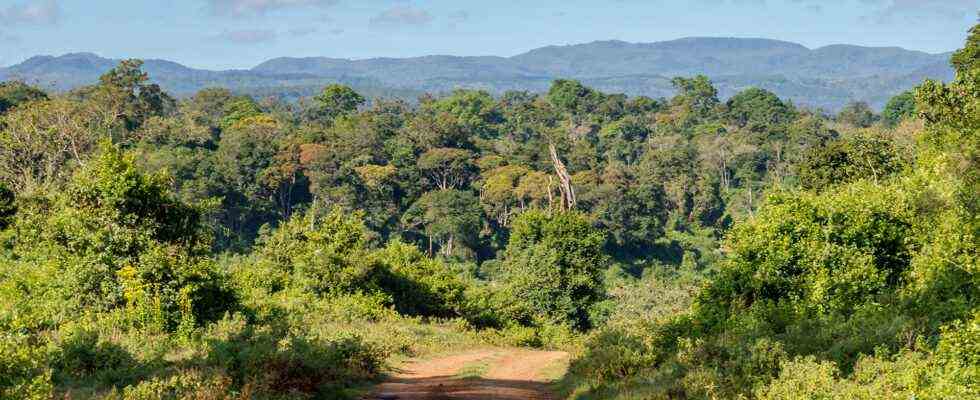Status: 14.09.2021 12:34 p.m.
African mountain rainforests store more carbon than originally thought. Their individual trees even surpass those of the Amazon. But Africa’s rainforests are also endangered.
He rises majestically from the plain, the elephants graze at his feet. Its white top is world famous: Kilimanjaro in Tanzania is a place of longing. Many dream of climbing the top of the highest mountain in Africa once in their life. They would also have to climb through his rainforest belt – but it is threatened. The tropical mountain forest is shrinking. “The loss of forest on Kilimanjaro in the last 140 years has been around 50 percent,” explains Andreas Hemp, biologist and researcher at the University of Bayreuth. The African tropical mountain forest is important for the local climate and precipitation – and seen worldwide as a carbon store.
For a long time it was thought that this rainforest, as it also grows on Kilimanjaro, would store less than the lowland rainforests of the African Congo Basin. But this year an international team of researchers proved its importance. They examined 44 mountain regions in twelve African countries. Their result: The mountain forests store significantly more carbon than assumed, on average just under 150 tons per hectare, which is comparable to the lowland rainforest in Africa. The United Nations Intergovernmental Panel on Climate Change (IPCC), on whose behalf scientists repeatedly analyze the current state of knowledge about climate change, has so far assumed just under 90 tons.
The individual trees here store more carbon on average than those in the Amazon in South America. “The forest on Kilimanjaro in particular has a lot of biomass because it is very humid and the soil is very rich in nutrients,” says Hemp. “We found the tallest trees in Africa there, they are over 80 meters high.”
The ascent to Climanjaro is difficult for tourists – and gives an idea of the threat to the mountain forests of Africa.
Image: picture alliance / dpa
Deforestation and fire hazard
But these forests are threatened. Scientists estimate that around 800,000 hectares of the ancient rainforest have been lost since 2000. On Kilimanjaro, there are two factors that are important, explains Hemp. On the one hand, fires, which are more damaging to the forest than in the past due to the drier climate. The last major fire broke out in October 2020, and the extinguishing work at around 3500 meters was difficult. On the other hand, it is illegal logging. That is why Kilimanjaro has now become part of the national park and is therefore better protected.
The forest is not only important for storing carbon, it also influences the local climate. “The forest means life,” says Hemp – “for animals, plants and people. Especially with regard to the water in the region. The mountain forest is a huge reservoir of water. It stores around 500 million tons of water a year. That.” he then returns in small portions. ”
This is crucial for the people who live at the foot of the mountain. Without the remaining mountain forest, Kilimanjaro would be much drier. “Kilimanjaro is the main source of water for around 1.3 million people,” says Neduvoto Piniel Mollel. The Tanzanian scientist has been researching the tropical rainforest for 20 years and works in the National Herbarium of Tanzania. In addition, “the forest is a reservoir of useful plants, for medicine, firewood, building material or food”.
Better protection of the forests requires “afforestation, holistic water management and sustainable agriculture. Such programs must be implemented, especially at the foot of the mountain,” she explains. “The local people must be educated about nature and environmental protection, this sensitizes them for the sustainable use of natural resources.”
In October 2020, fires will blaze again on Kilimanjaro. The extinguishing work is always particularly difficult here – because of the altitude, the winds and the dry vegetation.
Image: picture alliance / dpa
The settlements are getting closer
The air is cool and humid, and white lichens hang from the trees in long threads. The deep silence in the forest of Aberdare National Park in Kenya is only broken by the rush of the water. But the peaceful atmosphere is deceptive, this forest is also under pressure. The settlements that spread around the mountain range are getting closer and closer to the park boundary.
In addition, people keep climbing into the national park and illegally chopping wood. These remaining forests and their ability to store, understand and preserve carbon are particularly important here in East Africa, as the lowland rainforest there has already disappeared and the mountain forests are the last stands of the evergreen old forest, the scientists say in their study.
Because: “Deforestation continues,” explains Aida Cuni-Sanchez from the Norwegian University of Life Sciences, who is also the author of the study. “In the protected areas, the laws need to be better enforced. Outside these areas, the forests could benefit if they were managed by the communities living there. And the international community must support the better management of these forests.” So that they have a chance to be preserved.

